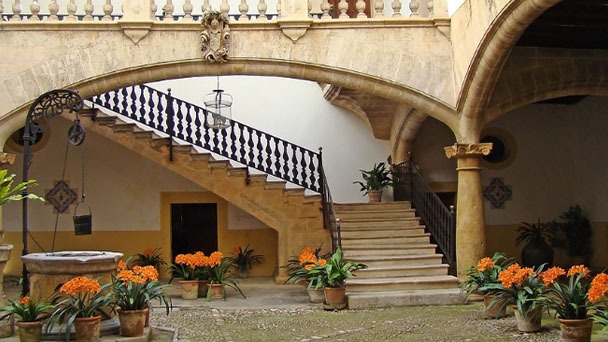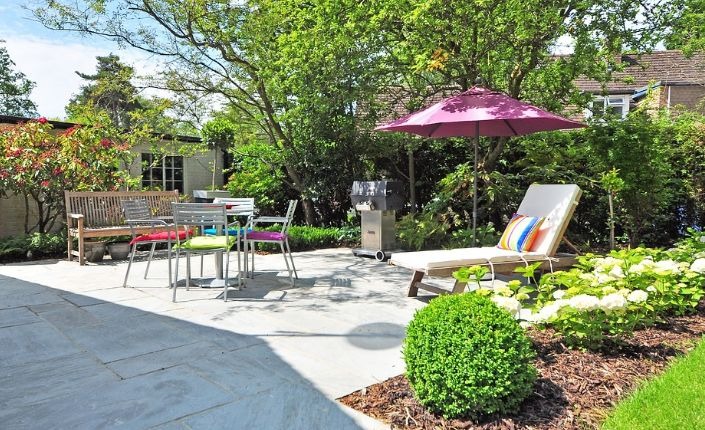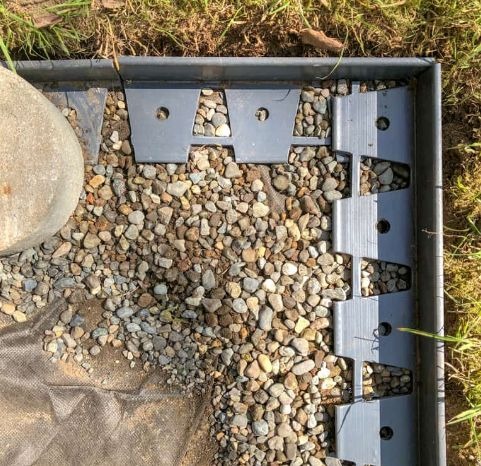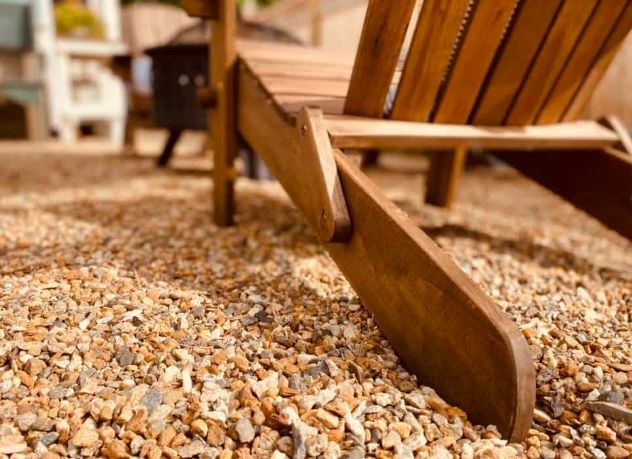Pea Gravel Patio Pros and Cons - 2023 Comparisons
Written by Ivy
Jan 10 2023

Due to their ease of installation, affordability, and low maintenance requirements, pea gravel patios have gained popularity. You improve the home's functionality and aesthetic appeal. Therefore, you should think about one if you want to remodel your outdoor area.
Is this a wise decision for your house, though? Why is it better than bricks or pavers? Before choosing, there are a number of pea gravel patio benefits and drawbacks to consider, and we've gathered them all in this thorough guide.
You will learn the advantages of setting up a pea gravel patio as well as how to deal with the disadvantages. We also address a few other typical queries from homeowners. Let's get started!
What is Pea Gravel Patio?

Small, rounded stones known as pea gravel are employed in landscaping, drainage systems, and other structural construction projects. The name comes from the fact that it's usually the size of a green pea.
Between 1/8" and 3/8" in size, pea gravel is available in a variety of hues and shapes. Various colors, including brown, yellow, gray, and black, are also offered.
Pea gravel is frequently used for a variety of outdoor tasks by both cities and homeowners. Uses range widely and include construction, gardening, and landscaping. Pea gravel is excellent for patios and walkways because it makes surfaces more permeable and gives them a more organic, natural feel.
What advantages does a pea gravel patio provide, then?
Pea Gravel Patio Pros
The benefits of installing a pea gravel patio are listed below.
Very Affordable
Pea gravel can typically be used to cover an entire patio with just 1 ton of material. To stop weed growth in the future, you should lay down some landscaping fabric before laying the stones in your yard. Prior to delivery, the ground may need to be compacted at some properties. You simply need to gather the gravel and place it where you desire it, and your new patio will be ready for use. The project can typically be completed in a single day and is less expensive than pavers and flagstone.
Since it is less expensive, it is best to purchase pea gravel in bulk. For instance, the cost of a ton of plain, grey pea gravel ranges from $25 to $53. The price may also change depending on the size, color, and general level of quality.
Low Maintenance
Pea gravel maintenance is similar to that of many construction projects. In contrast to concrete or pavers, which frequently have cracks or grout, it is simpler to maintain. Its surface can be kept up by simply raking and regularly weeding. Pea gravel does not require resealing or repainting.
Prevents Weed Growth
There is still good news if you don't want to spend the time laying down a landscaping fabric before you lay the pea gravel for your porch. When this landscaping material is at least 4 inches thick, it will naturally stop unwelcome weeds from growing in your patio. This benefit also means that a thicker layer avoids messes more frequently than other materials because rain won't turn it muddy. By using this material for your patio, you can expect to see fewer pest issues on your property.
Readily Available
Here's some good news if you're considering building a pea gravel patio on your property. You'll discover that the majority of retail suppliers have it for sale. The majority of hardware stores sell this product by the bag if your neighborhood doesn't have a landscaping service. To start building your new patio gradually, you can even shop online through Amazon and buy this product 5–40 pounds at a time. In this way, regardless of where you live, you can design the ideal backyard oasis.
Versatile and Customizable
The various shapes, hues, and textures of pea gravel can be used in inventive ways. Pea gravel is a superior choice to other materials because it can be easily customized to fit the shape of your patio.
Pea gravel is a versatile material that can be used for both small and large spaces, walkways, patios in gardens, etc. Stones and pea gravel can be combined to create a stunning landscape feature. Pea gravel can also be used to hide a sizable uneven area.
Promotes Water Drainage
Pea gravel is very popular because many homeowners want to make their homes eco-friendly. Although concrete may seem like a good material for landscaping, it isn't eco-friendly because it doesn't support adequate drainage. Concrete patios are frequently connected with surface water runoff.
Pea gravel patios, on the other hand, are constructed from absorbent materials that aid in drainage and prevent erosion. Pea gravel allows water to soak into the stones, as opposed to concrete patios, which must be supported on an angle for water to drain off. Due to its permeability, pea gravel is used frequently in mass landscaping and construction projects.
Natural and Eye-Catching
Pea gravel can be used anywhere because of its many colors and organic appearance. The diverse range of colors is typically brought on by natural weathering.
With the range of colors available, you can create a pea gravel patio that looks as natural as possible by coordinating it with your surroundings and outdoor decor. Your patio and landscape can look more appealing by combining different colors.
Easy to Walk On
You can walk on pea gravel without difficulty if you wear supportive shoes. Pea gravel is simple to walk on due to its small size, round shape, and smooth surface.
Additionally, after a few years, the pea gravel surface hardens and becomes impervious to placing objects. Because of this, people of all ages—including children and dogs—can play safely on the pea gravel patio.
Easy to Install
Patios made of pea gravel are simple to install, which lowers the cost of labor. And unlike pavers, you don't need advanced skills.
Through a YouTube video, you can quickly learn how to install something. Up to 6 inches of soil must typically be dug out and tamped prior to installation.
Suitable for Fire Pit
How romantic it will be to spend a chilly evening with family and friends around a fire pit on a pea gravel patio. Patio fire pits are great places to spend time with family and have fun.
Pea Gravel Patio Cons
A pea gravel patio has advantages, but there are also disadvantages. Making an informed decision requires that you be aware of the drawbacks.
If you know how to work around them, the drawbacks are usually not too significant. The disadvantages of installing a pea gravel patio in your area are listed below.
Easily Displaced
This is arguably the biggest disadvantage of a pea gravel patio. The patio is movable and unstable. Therefore, the pea gravel moves over time even if you take extra precautions.
However, you can solve this issue by regularly adding more gravel or edging the area. To keep the gravel from shifting after you've edged it, you can add a border around it.
Chances of Weed Growth
Pea gravel aids in preventing weed growth at the soil level, but it does not prevent weeds from growing on the patio. If the soil contains organic components that encourage seed germination, weeds may come back.
The best way to stop weed growth is to use landscaping fabric. Between the gravel and the ground, this acts as a weed barrier layer to stop weed growth. To reduce the possibility of weed growth, install the landscaping underneath the patio.
Furniture May Sink and Become Uneven
Furniture may sink into the pea gravel patio's shifting surface, making chairs and tables uneven. The furniture legs may need to be firmly anchored into the gravel for support. Consider choosing a 6-inch gravel depth or using a firm base for balance if this will serve as your dining area. Additionally, choose wider furniture legs over sliding ones.
Additionally, you could place supports directly on the ground, like cinder blocks. After that, cover the cinderblocks with pea gravel.
Difficulty Removing Snow
Using a pea gravel patio makes it difficult to clear snow and remove debris. To avoid removing the top layer of pea gravel, you'll need to be careful when shoveling. To melt ice without damaging the patio, use salt.
Uncomfortable for Bare Feet
A pea gravel patio might not allow you the luxury of going barefoot on the patio, particularly in the summer. The pea gravel patio is smooth and easy to walk on, but it has sharp edges that are uncomfortable for bare feet.

Gravel Polishes Itself over Time
You will notice that the pavers and flagstones that you use with pea gravel on your patio gradually polish and shape themselves. The pebbles have a marble-like appearance as a result of constant foot traffic. The patio might need to be refilled to keep its small size.
Patio Furniture on Pea Gravel
How can the aesthetics of your pea gravel patio be improved now that it has been installed? To begin with, furniture gives your patio some finishing touches. Some furniture designs and shapes go well with a pea gravel patio. And some don't.
Loungers, coolers, and furniture with wheels are inappropriate for the patio. Additionally, since their legs can sink into pea gravel patios, furniture with thin legs doesn't work well there.
The best furniture for a pea gravel patio is evenly distributed weight, as these items won't sink. Make sure to choose pieces of furniture with a wider base. To support patio furniture, you could additionally add a layer of pavers, rubber, or wood.
After putting the material underneath the chair or table leg, surround it with gravel to hide it. Fixed furniture can be used with this technique. Make sure to place stability first when selecting patio furniture.
The material from which patio furniture is made determines its durability. Even though metal and wood are sturdy, the stone can still scratch them. Your furniture's appearance could be altered by this, particularly the base. Additionally, a material that has been scraped will probably sustain more harm.
Plastic is a better option because it is less likely to be damaged, even though it isn't the top material for outdoor furniture. Plastic can also be scraped, but unlike rot or rust, it doesn't cause additional harm.
Make sure the metal patio furniture you are considering has a protective coating to guard against weather and other damage. Additionally, you should try to protect the area at the base of the furniture because that is where the majority of wear and tear happens.
Tennis balls cut open are sometimes used around the base of furniture in parks and schools. Although it may not be aesthetically pleasing, this is protective and enhances functionality. You might be able to think of something else that accomplishes the same thing but looks better.
Common Questions of Pea Gravel Patio
Is a Pea Gravel Patio a Good Idea?
Pea gravel patios are simple to install, affordable, low maintenance, help with water drainage, versatile, and adaptable. It also discourages weed growth, is easily accessible, and is attractive. A pea gravel patio makes sense given the advantages listed above.
Do Pea Gravel Patios Last?
Patios made of pea gravel do not deteriorate or crack over time like pavers and stones do. As a result, they are strong and long-lasting. After a while, if any stones become loose, you can replenish them by buying more at the nearby local store.
Is Pea Gravel Hard to Maintain?
While cleaning pea gravel can be challenging over time, it is simple to maintain in the short term. To keep dirt off the surface, you'll need to rake the stones frequently or use a leaf blower. Unevenness and loss of rock density can be fixed by adding more gravel.
How Thick Should It Be?
For the stone base (10 cm) and decorative gravel (3 cm) to fit perfectly, a pea gravel patio should be between 3 and 5 inches thick (or 13 cm deep).
How to Clean a Pea Gravel Patio
The patio can be cleaned with a hose, bucket, and dry/wet vacuum. The likelihood of some stones being sucked up during vacuuming is high. Fill a bucket with water after emptying the debris and stones into it. The stones will be below the water and the debris will float on top of it. Remove the debris that is above water.
To get the dirt loose, be sure to mix the stones in the water. You can spread the stones out on the patio after the dirt has been removed by scooping them out of the water. To fill in any gaps, distribute them evenly. It might seem overwhelming to clean, but you can reduce stress by getting help or cleaning outside on a sunny day.
How Much Pea Gravel is Needed for a 12×12 Patio?
Measure the patio and calculate the gravel and other materials to determine how much pea gravel you'll need for a 12x12 patio.
How much pea gravel you need for your patio can be calculated here.
Using a measuring tape, determine the patio's width and length.
To find the square footage, multiply the length by the width. For instance, the square footage of a 12x12 patio is 144 square feet.
T
ypically, a base layer of gravel patio should be 4-inches deep. 4 inches equals one-third of a foot. Calculate how many cubic feet of gravel are required by multiplying 144 square feet by one-third. The gravel you need for your patio is 44 cubic feet.
Most frequently, cubic yards of gravel are sold. To calculate the cubic yard, multiply the cubic feet by 27, or 44 by 27, for a result of 1.6 cubic yards. Next, increase the cubic yard by 5% to account for adjustments and allowances.
Depending on the kind of soil you're working with, you might also need a base material in addition to gravel. This will typically be sand or, more frequently, crushed stone.

Some Maintenance Tips
Rake the Gravel Surface
Raking the surface will be preferred because pea gravel frequently moves or shifts. Raking aids in leveling out low areas and keeps gravel in place.
Weed the Patio
Weeds growing up soon after a patio is installed is not surprising. The weeds are easily removed by hand. Or, you could use an herbicide (check the label and observe safety precautions).
Using hot water is a traditional method of weed removal. Herbicides can be effectively replaced by this natural method.
Get Rid of Potholes
Small and large gravel should be used to fill potholes. Before adding large gravel, first pour fine sand to create the base. To make the gravel and sand compact, level the area next. As materials may settle with time, it may be a good idea to overfill potholes.
Create a Drainage System
When leveling the gravel, make sure the center is higher than the other sides because this prevents water from accumulating in the center and creating potholes.
Remove the Leaves
The patio will eventually experience leaf erosion. To get rid of the leaves, use a leaf blower. When the leaves are completely dry, it's best to remove them. Wet leaves are difficult to remove from gravel because they become glued to the surface.
Add a Fresh Layer of Gravel
Every two to four years when it thins out, add more gravel. It should be evenly distributed all around the patio. Make sure it is properly layered to discourage water accumulation and encourage effective drainage.
That's it; you'll see that maintaining a pea gravel patio doesn't require a lot of work if you strictly follow the maintenance advice.
Latest Updated
- Benefits of Bugleweed - 7 Science-backed Health Benefits
- Bugleweed Dangers & Side Effects - Is It Poisonous?
- How to Plant Evergreen Trees - What You Should Know
- When to Plant Evergreens - Grow Guide for Evergreen Trees
- 12 Wonderful Evergreen Shrubs for Your Garden
- 12 Popular Evergreen Plants with Pictures for Beginners
- When And How To Prune A Lilac Bush Like a Pro
- How to Grow & Care for Lilac Vine (Hardenbergia Violacea)
- Japanese Lilac Tree (Syringa Reticulata) Care & Propagation Guide
- Shumard Oak Pros and Cons - What to Know
Popular Articles
- Winter maintenance of Antirrhinum Majus
- How to Grow Terminalia Mantaly Tree
- How to Grow and Care for Crossostephium Chinense
- How to grow Antirrhinum Majus in spring
- Peristeria Elata (Dove Orchid) Profile: Info & Care Guide
- Underwatered Snake Plant (Sansevieria Trifasciata) - Signs And How To Fix
- How to Care for Brazilian Jasmine Plant (Mandevilla Sanderi)
- How to Grow & Care for Graptopetalum Purple Delight in Summer
- Rosa Chinensis (China Rose): Plant Growing & Care Tips
- How to Care for Baby Sun Rose (Aptenia Cordifolia)